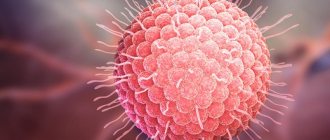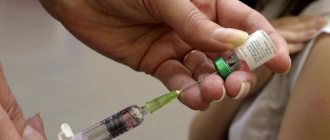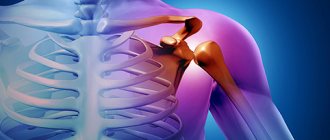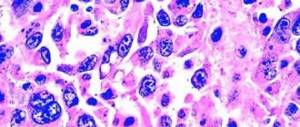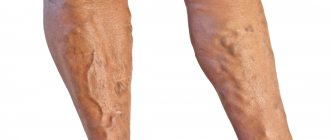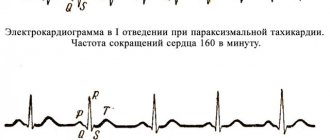Kaposi's sarcoma is a tumor that develops from endothelial cells. Kaposi's sarcoma has a variable clinical course ranging from minimal mucosal involvement to extensive visceral involvement. Kaposi's sarcoma was first described in 1872 by Hungarian dermatologist Moritz Kaposi. Kaposi's sarcoma can be divided into 4 types:
- AIDS-associated Kaposi's sarcoma - This type of sarcoma occurs in people with HIV infection. This type of Kaposi's sarcoma is the most common malignancy in HIV-infected individuals.
- Kaposi's sarcoma in immunocompromised individuals - this type of sarcoma occurs among individuals who have undergone solid organ transplantation (the risk of developing Kaposi's sarcoma increases 100-fold) and in those who have undergone or are undergoing immunosuppressive therapy. However, people with congenital immunodeficiency disorders are not at increased risk of developing Kaposi's sarcoma. This type of sarcoma is very rare. The average time for development of Kaposi's sarcoma after organ transplantation is 15-30 months. An aggressive course involving internal organs is a common picture. However, withdrawal of the patient from immunosuppression may lead to regression of this condition. This suggests that immune suppression may play an important role in the development of Kaposi's sarcoma.
- Classic shape. This type usually occurs in older men living in the Mediterranean region and Eastern European countries. The male to female ratio is 10-15:1. The age at which the onset of development of Kaposi's sarcoma is noted is from 50 to 70 years. Classic Kaposi's sarcoma, as a rule, is characterized by a protracted course and is painless. Common complications include venous stasis and lymphedema. More than 30% of patients may subsequently develop a second malignancy, usually non-Hodgkin's lymphoma. The occurrence of this type of sarcoma in older adults may be associated with age-related suppression of the immune system, a history of treatment for other neoplasms, and possible concomitant infections such as malaria.
- Endemic (African) form. This type mainly occurs in HIV-seronegative males, and slightly less frequently in women and children living on the African continent. This type is characterized by an aggressive flow course. This type was relatively common before the AIDS epidemic. With the advent of AIDS, the incidence of this form of Kaposi's sarcoma increased approximately 20-fold. In the African countries of Malawi, Swaziland, Uganda, Zambia and Zimbabwe, Kaposi's sarcoma has become the most common form of cancer in men and the second most common cancer in women. This form accounts for about 9% of all cancer cases in males in Uganda.
Those Kaposi's sarcomas that are associated with AIDS, unlike other forms, are characterized by an aggressive clinical course. This type is the most common.
What is Kaposi's sarcoma
Kaposi's sarcoma is an oncological disease characterized by the formation of multiple foci of cancerous growth.
As a rule, this disease affects the skin, but sometimes sarcoma spreads to the lymphatic system, affecting the intestinal mucosa, stomach, and lungs. Men get sick more often. A description of the disease was compiled in 1872 by dermatologist Kaposi from Hungary. The disease is manifested by pathological proliferation of blood vessels due to excessive division of endothelial cells, which ultimately leads to damage to the skin. It manifests itself as purple or purple plaques and nodes and swelling of the surrounding tissues.
The disease sometimes develops rapidly, with a quick unfavorable outcome (deformation of the limbs, heavy bleeding from tumors, lymphostasis, infection), and sometimes progresses gradually, up to 10 years or more. This course of sarcoma is called chronic.
Photo
Stages of development
The disease has 4 stages of development:
- At the first stage, the neoplasms are small in size. The tumor is harmless, does not affect the functioning of the organ, there is also no effect on the tissue, there are no symptoms, there are no metastases.
- Located inside the organ. Such tumors are characterized by growth, often compressing surrounding tissues, and malfunctions in the functioning of the structure are observed. There are no metastases.
- The disease spreads beyond the infected organ. Metastasis affects the lymph nodes.
- The fourth degree is characterized by a large tumor; it grows into the surrounding structures, squeezing them. Metastases are possible in all lymph nodes, brain, liver, and bones.
The disease can occur:
- Spicy;
- Subacute;
- Chronically.
The acute course is characterized by lightning-fast generalization of the tumor process with signs of intoxication; death is expected within a period of time from a couple of months to 2 years, this depends on the somatic status of the body. The subacute course is characterized by the duration of the disease from two to three years. The chronic course is characterized by the gradual development of clinical symptoms, which lasts eight years or more.
The main complications of sarcomatosis include bleeding from ulcerations as a result of the disintegration of tumors, damage to the extremities in the form of limited movement and deformities. The addition of a secondary infection leads to the development of sepsis and is the cause of death of patients.
Symptoms of Kaposi's sarcoma
The development of the disease is accompanied by an increase in malignant neoplasms. Foci of cancerous growth have a dense consistency and are painful on palpation. Over time, pigment spots and scars form at the site of cancer rashes. At the final stages of the disease, regional lymph nodes are damaged and multiple metastases form in the lungs and liver.
Characteristic symptoms:
- neoplasms on the body are slightly convex or flat, resembling small nodules or spots;
- the color of the spots is dark, purple or red, does not change when pressed;
- smoothness of the spots, presence of internal hemorrhages, swelling of adjacent tissues;
- involvement in damage to internal organs, mucous membranes and lymph nodes.
Sarcoma spots on the body behave differently. Some people observe formations in only one area of the body, while others experience new marks with regularity once a week or month. The frequency of manifestations is determined by the weakness of the human immune system.
In cases of acute cancer intoxication, the following symptoms appear:
- persistent increase in body temperature;
- acute pain syndrome, which can only be relieved with the help of narcotic analeptics;
- malaise, fatigue and loss of performance;
- decreased appetite and body weight.
Kaposi's sarcoma in HIV
Kaposi's sarcoma occurs more often in HIV-infected patients and is considered a type of cancer. The increase in the number of AIDS patients has led to an increase in the incidence of sarcoma. The disease in the presence of HIV infection in the patient’s body is classified as epidemic type. The risk group is young people under 40 years of age.
Three flow options:
- acute: sarcoma develops rapidly, death occurs 2 years after the onset of the disease;
- subacute: if treatment is ignored, the patient’s life expectancy is 3 years;
- chronic: considered a benign course of sarcoma, the patient can live fully without treatment for 10 years or more.
Symptoms and signs:
- formation of pink-blue spots on the skin;
- formation of nodes and ulcers;
- body aches and muscle pain;
- weakness;
- swelling of the limbs;
- enlarged lymph nodes;
- the appearance of a rash on the mucous membranes;
- burning of the skin;
- damage to internal organs.
Clinical manifestations
Immunosuppression is one of the conditions for the development of the disease. When the number of CD4 lymphocytes in HIV patients is relatively high, the tumor develops slowly, and when the number of CD4 lymphocytes is below 200 in 1 μl, it develops quickly. With the development of Pneumocystis pneumonia or with prolonged use of corticosteroids, Kaposi's sarcoma in patients develops rapidly.
The main features of the disease in patients with AIDS:
- Young age - up to 35 - 40 years.
- The development of a tumor process is observed in every third patient. Basically, these are people of homosexual orientation and patients with sexually transmitted diseases.
- Sarcoma develops together with other opportunistic infections (often with Pneumocystis pneumonia).
- Localization of primary elements on the head, neck, upper half of the body and genitals.
- Widespread nature of the lesions (multifocality). Symmetry is not typical.
- Hemorrhagic spots are most often bright red, plaques and nodules are the main elements of the rash.
- The rashes often suppurate and ulcerate.
- Rapid generalization of the tumor process with damage to the lymph nodes, lungs, gastrointestinal tract and oral mucosa.
- Pronounced lymphostasis.
- High mortality (life expectancy of 80% of patients does not exceed one and a half years).
Rice. 6. Kaposi's sarcoma of the small intestine. The photo was taken during endoscopy.
Type of tumor
With HIV infection, rashes on the skin and mucous membranes look like spots (roseola), papules, plaques or nodules, often purple in color, less often purple or brown in color. The boundaries of the lesions are clear. The tumor elements are painless, the patient is rarely bothered by itching and burning. Over time, the rashes become numerous, in some places they merge, forming tumor-like formations, which over time begin to bleed, suppurate and ulcerate.
Rice. 7. Spots, papules, plaques and nodules are elements of Kaposi's sarcoma.
Localization
In patients with AIDS, tumor elements are localized on the face, nose, skin of the upper half of the body, genitals and around the anus. Less often - on the lower extremities, feet and palms. Often the mucous membrane of the oral cavity, lungs, and gastrointestinal tract is involved in the pathological process. Involvement of internal organs in the pathological process is associated with the presence of HHV-8.
With profuse rashes, when rashes appear on the lower extremities, lymphostasis develops, joints are affected, followed by the development of contractures.
Rice. 8. Kaposi's sarcoma in AIDS on the oral mucosa. Initial stage (photo on the left), advanced form (photo on the right).
Rice. 9. The photo shows numerous rashes on the mucous membrane of the gums due to disease.
Rice. 10. Kaposi's sarcoma on the hard palate.
Rice. 11. Kaposi's sarcoma on the tongue (photo on the left) and lip (photo on the right).
Forms of the disease
Skin damage. Skin lesions are recorded in 2/3 of cases. The process is characterized by rashes in the form of roseolas, papules, plaques and nodules, often purple or brown in color. The face, neck, upper half of the torso and anogenital area are the most common locations. The rash is painless, but when inflammation occurs, swelling and pain appear. Large tumor-like formations often suppurate and ulcerate.
Damage to mucous membranes. The rashes are most often widespread, localized on the mucous membranes of the nose (22% of cases), mouth and throat. In the mouth, tumor elements appear on the soft and hard palate (5% of cases), cheeks, arches, tongue, larynx and pharynx. As the process generalizes, the lesions become sharply painful.
Damage to internal organs. Damage to internal organs is observed in 75% of patients. The esophagus, intestines, spleen, liver, kidneys, lungs, heart and brain are affected, where infiltrates occur. When the pathological process spreads to the lung tissue, patients experience shortness of breath. More than half of patients do not survive beyond 6 months.
Rice. 12. Kaposi's sarcoma of the conjunctiva of the eye (photo on the left) and sclera (photo on the right).
Stages of the disease
Spotted. First, spots (roseola) appear. In AIDS, they have a purple or brown-red color, irregular round shape, 1 - 5 mm in diameter, with a smooth surface, painless, and not accompanied by itching. Most often they are located on the face, nose, around the eyes, palms, genitals, and on the skin of the upper half of the body.
Papular. Elements of the rash begin to rise above the surface of the skin and turn into papules up to 1 cm in diameter. They have a hemispherical shape, dense, elastic, insulated. When merging, plaques with a rough surface (“orange peel”) are formed.
Tumor. When papules and plaques merge, tumor formations are formed. Large nodes are dense to the touch, bluish-red in color, from 1 to 5 cm in diameter. Over time, they become covered with ulcers and begin to bleed.
Treatment of Kaposi's sarcoma
Treatment of Kaposi's sarcoma can last for years; as a rule, this concerns the epidemic form of the disease. Complex therapy (local treatment, injections and oral medications) has a lot of contraindications, but without treatment, serious complications incompatible with the patient’s life are possible.
In the classic form of Kaposi's sarcoma, results are achieved by radiation therapy of the affected areas. In the endemic form, chemotherapy is preferred. In the iatrogenic form, it is necessary to reduce the dose or discontinue immunosuppressants. In the epidemic form of Kaposi's sarcoma, local treatment is used, and in case of extensive damage to the skin and mucous membranes or damage to internal organs, chemotherapy is used.
To reduce tumor nodes and prevent the formation of new ones, the following techniques are used:
- Local treatment: use of creams, gels to block the growth of nodes. Weak effect in the later stages, but a positive therapeutic effect with early detection of formations.
- Radiation therapy: local irradiation of tumors to relieve pain, stop growth, and prevent relapses.
- Cryotherapy: is based on cauterization of skin fragments of the tumor using liquid nitrogen. Destroys cancer cells.
- Laser therapy: Pulsed dye laser is used to remove small superficial tumors. The method is effective, but expensive.
- Surgical treatment: aimed at large tumor formations, excision of a single tumor, treatment of damage to internal organs.
- Electrocoagulation: used to treat ulcerated, bleeding nodes.
Systemic therapy
Since the immune system suffers with Kaposi's sarcoma, drugs are prescribed that affect it, due to which the spots on the body disappear or new ones stop appearing. Alpha interferon, which is similar in composition to a natural substance produced by the human body's immune system, has been approved for the treatment of the disease.
Complex chemotherapy with the following drugs is also used:
- doxorubicin;
- etoposide;
- bleomycin;
- vincristine;
- palitaxel.
Chemotherapy has many side effects and this method is difficult for the body to tolerate, but there is no other way to influence the disease. The danger of using polychemotherapy for immunodeficiency is associated with the toxic effect of chemotherapy on the bone marrow, in combination with drugs used to treat HIV infection.
Palliative treatment
Like other palliative cancer treatments, this type of therapy for classical sarcoma is aimed at relieving the symptoms of the disease. Painkillers, creams and ointments to relieve itching are used in cases where antitumor treatment does not bring results. In this case, all that remains is to try to stabilize the condition and improve the patient’s quality of life.
Folk remedies
Folk remedies for Kaposi's sarcoma complement classical medications and the use of folk methods is controlled by the attending physician. This helps to avoid unexpected negative reactions of skin formations.
Prognosis for Kaposi's sarcoma
Mild forms with low malignancy do not interfere with the course of life until old age. Against the background of HIV infection, the disease sometimes reaches the final stage in weeks (the average for treatment is 2-10 years). However, proper treatment prolongs the patient's life if help is sought in time.
Often the sarcoma is put into remission, after which a course of immunotherapy (antiretroviral therapy) is prescribed, which does not require constant hospital visits. The main thing: you need to regularly monitor the presence of tumors on the skin, mucous membranes and lymph nodes, and undergo diagnostics every 6-12 months.
The malignant course is characterized by acute and subacute forms of classical Kaposi's sarcoma (death occurs within 1-3 years); in the chronic form, the course is usually benign. In immunosuppressive sarcoma that developed after transplantation, the prognosis is also unfavorable; sarcoma that occurs during immunosuppressive therapy is characterized by a benign course.
Symptoms of Kaposi's sarcoma are reversible, usually in patients with normal immunity. The primary goal of treatment for Kaposi's sarcoma is to increase the body's resistance. The prognosis of the disease is determined by the primary lesion, against which foci of tissue mutation develop. For example, a cancerous lesion in an immunodeficient state of the body has an unfavorable outcome.
Traditional medicine
Therapy of Kaposi's sarcoma using folk remedies is part of complex treatment. These treatment methods are not recommended for use as primary therapy and can only be used after consultation with a specialist.
If tumors appear on the skin in the summer, you should lubricate them with celandine juice; in winter, it is preferable to use a tincture of a dry plant to wash the patient and apply a bandage with ointment and herbs to his body.
To prepare the ointment, you need to sift the flour from the dried celandine through a fine sieve. Next, a tablespoon of dry fat is melted and mixed with a tablespoon of herbal flour, a drop of carbolic acid is added to increase the shelf life of the ointment.
You can use an ointment based on butter. To prepare it, you need to combine 3 tablespoons of butter with 50–60 grams of sweet clover flowers.
In addition, the following drinks are consumed:
- ugly juice - the dosage is determined at the rate of 20 drops of the product for each year of life;
- aloe tincture - combine 5 finely chopped aloe leaves and 500 milliliters of vodka, take a tablespoon three times a day.
Classification of Kaposi's sarcoma
There are 4 clinical forms of Kaposi's sarcoma, which are characterized by symptoms, territorial affiliation of the patient and prognosis for the course of the disease.
- Classic type: patients are residents of European countries. The spots appear on the hands, feet and legs and are not accompanied by burning or itching. The disease goes through three stages: spotted, papular (the spots become denser, merge) and tumor-like (the formations turn into nodes and ulcerate).
- Endemic type: common among the inhabitants of Central Africa. It appears in early childhood (up to 1 year), is localized on internal organs and lymph nodes, and does not appear on the skin.
- Epidemic type: early-age (up to 40 years) disease that manifests itself in HIV-infected patients. It is characterized by a rapid course and danger to the patient’s life. The diagnosis automatically diagnoses the patient with AIDS.
- Immunosuppressive type: Kaposi's sarcoma with a positive prognosis for cure. It appears when a kidney or other organ is transplanted to a patient due to the complex use of immunosuppressants (medicines aimed at preventing tissue rejection).
According to the course, acute, subacute and chronic forms are distinguished. This division is arbitrary, since the subacute form, with adequate therapy, sometimes becomes chronic, and the chronic form, with irrational treatment, acquires features characteristic of the subacute. Nevertheless, the identification of individual types of the disease and forms of the course seems appropriate, since the pathogenesis, clinical picture, intensity of the pathological process, as well as the prognosis for life differ in each case.
The acute form is distinguished by rapid generalization of the process. Increasing symptoms of intoxication and cachexia cause death within 2 months - 2 years. The subacute form has a less intense and less malignant course. The duration of the disease without treatment is 2-3 years. The chronic form, in which the duration of the disease is 8-10 years or more, has a relatively benign course and gradual progression of the process.
Symptoms of a malignant tumor
The main pronounced symptoms of the development of Kaposi's sarcoma are the occurrence of itching and burning in the affected areas.
Symptoms of Kaposi's sarcoma
In addition to them, there are the first symptoms of Kaposi's sarcoma:
- Color.
- Localization of formations.
- Feelings from neoplasms.
- Tumor shape.
Color varies from bright burgundy to purple. The formations are glossy. They may peel off.
Occurs on the lower extremities, on the folds of the face. If the formations are localized on the mucous membranes, diarrhea, bloody sputum when coughing, and pain when swallowing food are possible. When malignant neoplasms occur in the gastrointestinal tract and lungs, the risk of damage increases.
Form of formations
A flat or minimally raised spot on the surface of the skin. Multiple rashes are possible.
The disease occurs without symptoms. The appearance of itching, peeling, and swelling is possible in the later stages of development.
It proceeds slowly, but progresses regardless of the form. If the tumors are injured, bleeding may occur. The tumor represents the emergence of a new network of blood vessels.
Symptoms vary depending on whether the skin or internal organs are affected.
Typically, neoplasms do not cause serious problems because they are painless. But if you ignore the disease and do not choose the right treatment strategy, the lesions will spread throughout the body. The lower a person’s immunity, the faster this happens.
Sarcoma, localized in the oral cavity and on the tongue, causes pain, which makes eating difficult. Late tumors affect the digestive system and can cause abdominal pain and bleeding.
When lung sarcoma is affected, problems with the respiratory system appear.
Spread to internal organs is a serious problem and threatens the patient’s life.
Diagnosis of Kaposi's sarcoma
Diagnosis of Kaposi's sarcoma is based on the characteristic clinical picture and the results of histological examination of biopsies of the skin or mucous membrane. Laboratory diagnosis provides a report indicating the type, extent and stage of the malignancy. To identify possible tumor metastases, oncologists recommend X-ray examination and magnetic resonance imaging.
An accurate diagnosis is only possible after the following tests:
- Examination of the body, mucous membranes and genitals.
- Biopsy and subsequent histology (examination of affected tissue to identify the type of tumor).
- Ultrasound diagnostics of lymph nodes and abdominal cavity.
- Endoscopic and retromanoscopic examination of the digestive tract.
- Bronchoscopy and x-ray of the lungs.
- Detailed immunogram.
- Blood test for the presence of herpes virus type 8.
Differential diagnosis
Differential diagnosis is made with vascular diseases characterized by the formation of macular nodular elements:
- telangiectatic Kaposi's pseudosarcoma;
- Stewart-Bluefarb pseudosarcoma;
- intravascular papillary endothelial hyperplasia;
- bacterial angiomatosis.
Sometimes Kaposi's sarcoma has to be differentiated from the following diseases:
- pigmentary and other forms of lichen planus;
- fixed drug erythema;
- leiomyoma;
- leiomyosarcoma;
- hemangiopericytoma;
- melanoma;
- sarcoidosis.
Causes of Kaposi's sarcoma
Today, doctors agree that the disease is caused by herpes type 8 in combination with a severe decrease in immunity, which is characteristic of the human immunodeficiency virus. Viruses, when activated in the body, lead to cancer problems.
Risk groups include:
- HIV-infected men.
- Older men of Mediterranean origin.
- Persons from equatorial Africa.
- Persons with organ transplants (recipients).
The main risk factor for the development of the disease is the presence of AIDS. The likelihood of Kaposi's sarcoma in men with immunodeficiency syndrome is 50-60%. For HIV-infected patients, this type of cancer is the most common.
Features of pathogenesis
The peculiarity of the disease is that it does not require additional diagnostic methods, and also does not require targeted treatment. This is explained and confirmed by such facts as:
- Kaposi's sarcoma is a consequence of an oncological process occurring in the body, which cannot be completely stopped.
- The disease cannot be cured, and selected palliative therapy is aimed at slowing down the process of cell degeneration.
- Skin cancer is characterized by a relatively slow progression and in rare cases causes death.
The histological structure of the tumor is presented in the form of many thin-walled vessels and spindle-shaped epithelial cells, which are combined into bundles. The tumor is infiltrated with lymphocytes and macrophages, and also contains small capillaries, which increases the risk of bleeding if it is damaged.
Prevention of Kaposi's sarcoma
Two types of prevention of Kaposi's sarcoma:
- primary: work to identify risk groups, examination, maintain immunity;
- secondary: refers to sick persons - this is inpatient treatment, observation, antiviral and preventive therapy, rehabilitation measures.
To reduce the risk of developing the disease, doctors recommend:
- Undergo complete associated prophylaxis for HIV infection and herpes virus epidemic.
- Treatment when HIV infection is detected.
- Regular check-ups with a doctor.
- Support immunity.
Discussion on the forum

